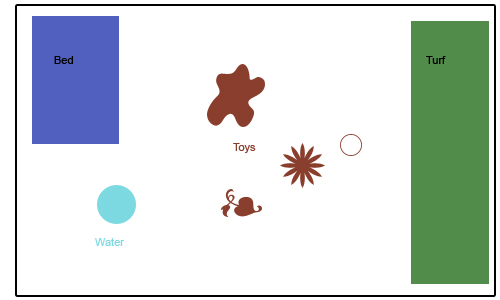Tag Archives: toilet training
Long Term Confinement Area for Puppies
This post is part of the series in response to Dunbar’s 2012 Australian seminars. See index.
New puppy homes need to have a long term confinement area set up ready for their puppy’s arrival. The idea is that, by using a pen setup in this way, the puppy will self-toilet-train and self-chew-toy-train. It also helps to teach the puppy to be alone. Long term confinement areas are designed so puppies learn where to pee and where to chew, and how to be alone. Basically, a pen like this allows a puppy to make correct choices, and so be successful in achieving appropriate behaviours.

Dunbar advocates for puppy pens to be set up with the bed far away from a toileting areas, as puppies are naturally inclined to toilet away from their sleeping area.
This pen has several features:
- The edges of the bed can (and should!) be taped down to prevent the puppy chewing the bed.
- Kongs should be used to distribute food in the middle. The Kong could be tied to the edge, to prevent it entering the toilet area, or you could raise the toilet area in a litter box so the Kong can’t roll in there.
- The toilet area should be turf and as far from the bedroom as possible, as puppies naturally want to eliminate away from their bed.
- The toilet area should have faeces removed as soon as possible, but the urine should be left so that the odour attracts puppies to return to eliminate in the same spot.
- The water is near the sleeping area.
- There should be plenty of Kongs! Puppies should only be fed from Kongs.
Bringing Home a New Puppy (Dunbar)
This post is part of the series in response to Dunbar’s 2012 Australian seminars. See index.
When a person buys a new puppy, they need instructions on what to do right away. Any delay means that mistakes will be made and, potentially, the puppy will begin to display ‘bad habits’. Within 3 days these bad habits can form, and these type of habits are normally the behaviour problems that result in dogs being surrendered to rescue later in life.
Dunbar has produced two great publications called Before You Get Your Puppy and After You Get Your Puppy. Dunbar allows these materials to be freely distributed, and even has options to brand these materials (for example, with a dog training business name) before distribution – so both business owners and puppy buyers (and puppies!) benefit.
When a puppy buyer brings a puppy home, they should have ready for them:
- A long term confinement area,
- A short term confinement area (i.e. a crate),
- Food toys, like Kongs (at least 6) to feed the puppy from.
The puppy should be confined to the long-term confinement area when their owner is not home, and be crated when they are home (or directly supervised). Every hour the puppy should be taken to a toileting area, where the owner stands still and waits for the puppy to elimination. The puppy should receive 3 treats after elimination, and then take the puppy for a walk (as a reward). The puppy should not be taken inside immediately, as some puppies find this punishing.
What can breeders do?
Breeders should begin toilet training and chew-toy training puppies before they go to their new homes. Breeders should distribute the Before and After You Get Your Puppy resources to new puppy buyers, and ‘quiz’ them in their content before they take their puppy home. Breeders have a responsibility to say, “No” if a puppy buyer is not ‘ready to go’ as soon as they bring their puppy home. If not, the breeder runs their risk of one of their puppies developing behavioural problems that leads to their shelter intake.
More details on the long term confinement area’s setup will be described in the next post.


